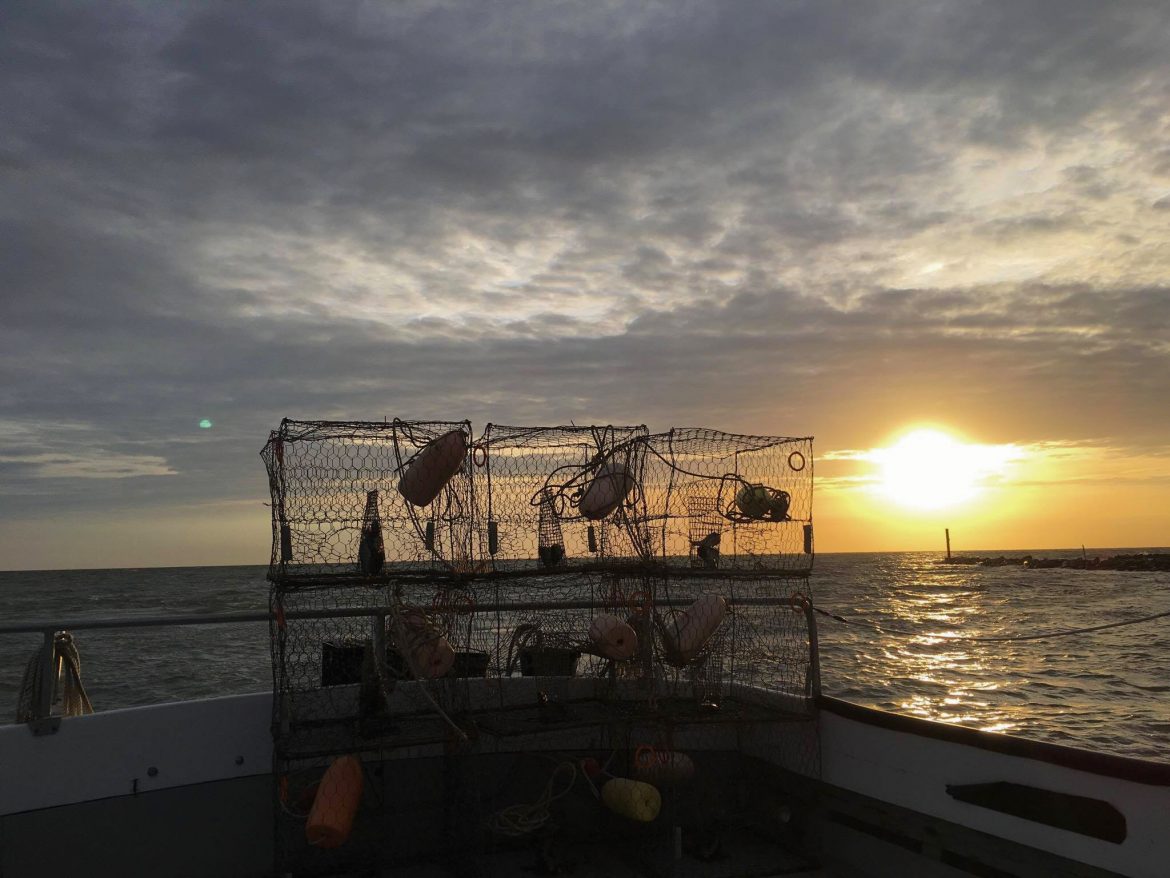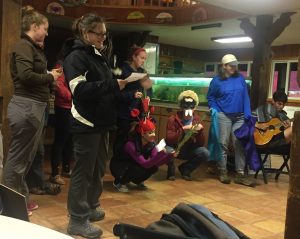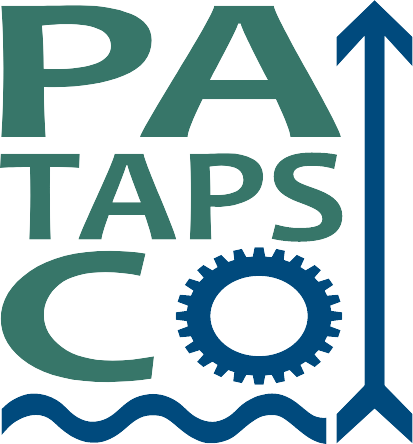
[Photo Credit: Malia Pownall, Chesapeake Bay Trust Conservation Member]
As we all looked back in silence at Port Isobel on the boat ride back to the mainland, I felt the midday sun and a slight breeze on my skin, and also felt a sense of longing to stay another day. The past two and a half days had left a warm glow within my core, and as I did a few yoga poses while the boat swayed and rolled with the waves, I let the experiences sink in deeper.
Roughly thirty corps-members spent time together on the island, and during the first meeting with the Chesapeake Bay Foundation staff, we were split into three groups and assigned two MWEE’s (Meaningful Watershed Educational Experience), an immersive field experience and a service project. The group I was a member of, Group 3, explored the East Salt Marsh the first afternoon and set up a shoreline fish trap the following morning.
For the immersive field experience, we gathered supplies and set out on a short hike to the high marsh. Osprey, seagulls, and egrets flew over our heads and the towering Loblolly and Virginia pine trees as we walked along a path lined by cordgrass and invasive phragmites reeds to a sandy beach, then a little further along the beach to the low marsh, where oystercatchers were nesting for the season. The high marsh was only about two inches further above sea level than the low marsh, but even that slight difference in elevation has a significant impact upon the ecology of the marsh.
As we walked along the beach, we noticed the whitened remnants of pine tree trunks. Our guide Adam explained that the saltwater from Pocomoke Sound intruded into the wood over time, slowly killing the trees, and that the sun had bleached the bark, giving it the eerie ghost-white appearance. The area of the sand we were standing on used to be a pine forest, but had turned to a sandy beach because of the rising sea level and subsequent erosion. He also explained that submerged in the saltwater tide of Pocomoke Sound, there were still tree trunks clinging to the now-inundated ground.
While in the low marsh, we walked atop the benthic algal mat and short stalks of salt grass photosynthesizing in the afternoon sun to wade into the shallow water. Almost immediately, our noses were permeated by a pungent odor. Adam explained that the smell was from sulphate in the ground of the marsh, which acts as the terminal electron acceptor in the decomposition of organic matter by benthic microorganisms, as opposed to oxygen gas or another electron acceptor. In layman terms, sulphate is responsible for the energy transfer between bacterium and microalgae in soil devoid of oxygen, which are instrumental in controlling the exchange of nutrients like nitrogen and phosphorus across the sediment-water interface.
In the tide of the low marsh, as our footsteps swirled the top layer of the algal mat into the water, we collected periwinkle snails and jellyfish with our nets. A few of us had our boots nearly swallowed by the marsh as we marshed around, but all boots were accounted for as we trekked back to higher ground.
Surrounded by tall salt grass in the high marsh, we pulled black needlerush stalks out of the sulphuric sediment, peeled back the green outer layer, and chewed upon the white inner layer. Our eyes lit up when we tasted the black needlerush We were all amazed that they tasted like almond cake, and shared smiles and laughs as we nibbled like muskrats.

Photo Credit: Tara Baker
The following morning, the writers, directors, and performers of “Muskrat Love” took part in the construction of a bank trap on the shoreline of Port Isobel. The previous year’s corps-members had begun the project, and it was our duty this year to replace a few wooden poles and install the fencing. Mary, Kathy, Ellie, and myself volunteered to immerse ourselves in the water with Adam, and the others helped to facilitate our dirty work. We were up to our bellies in brackish bay water removing and replacing poles in the silty ground. After a few minutes of us loudly exclaiming how cold it was with smiles on our faces, Andrew felt compelled to join us. The water was frigid and the black gnats were swarming, but all we could talk about after we completed the project was how much fun we had.
After we first set foot on Port Isobel and moved our luggage into Snow Goose Lodge, we explored the area before our introductory meeting. On the side of a shed was a painted map of the island, complete with different colors to highlight the different topographies, landmarks such as the various buildings and service projects, and trails weaving throughout the island. My eyes studied the details of the map. Written in pencil beside a trail that ended between the East Marsh and West Marsh, I noticed the words, “Sacred Bench.” Later on, I would learn that CBF also has a sacred bench at their Annapolis Office, but at the time I thought that it must have had some deeper legacy. After breakfast the following morning, with my alpaca blanket wrapped tightly around me as I carried a book, Earth Prayers, that I found in the peaceful poems drawer in the kitchen, I made a solo trek out to the sacred bench through the pine forest restored by CBF. Later that day, as most of the corps-members were out on the boat harvesting crab pots, I brought a small group to the sacred bench, which turned into a long walk along the beach and through the marsh. For the third and final visit to the sacred bench, I led another small group on a night hike after the bonfire. We sat together on the bench as we talked about our individual and collective futures while moving our eyes from one another to the array of stars overhead, and to the horizon, where the light of a distant lighthouse recursively returned to point in our direction. Each trip to the sacred bench was different, memorable, and full of beauty. The bench may not be a main attraction on the island, but it will forever be sacred to me.
Although there was a warmth within me as I reflected about the trip on the boat ride back to the mainland, I couldn’t help but also feel melancholy. I wished to stay, but I also wished that the islands themselves would stay. Both Port Isobel and Tangier are at most a few feet above sea level. The shorelines are eroding, at some places up to 15ft per year. There are talks of a new sea wall being built, but it keeps getting delayed as funding needs to be allocated and bureaucracy works at a slower pace than the pace of the rising seas.
At dinner the second day, the mayor of Tangier Island, known as Ooker, was a special guest. He talked with us about how Tangier Island needs a healthy bay to survive, as the economy of the community is dependent upon the yields of crab, rockfish, oysters, and eels that the Chesapeake Bay and Pocomoke Sound produce. He also discussed the sea wall with us. He smiled as he talked about potential the sea wall, as it would keep their community afloat, but after he said all that he wanted to say about it, he was quiet and looked somewhat dejected. I hope that the islands can stay above water both ecologically and economically, as they are beautifully unique and ultimately irreplaceable.
That is why I simultaneously felt profoundly elated and deeply sad. Although it was only a two and a half day trip, I couldn’t imagine a world without Port Isobel and Tangier, and I knew that the people that live there couldn’t either. After all, while I was only a visitor, it was their home, and although the source of their livelihoods is encroaching upon the longevity of their current lives, I could tell from listening to Mayor Ooker that the core of his being and the shared being of the Tangier Island community rises and falls with the tides, and rests within the shallow waters of the Chesapeake.
When your home threatens to destroy itself, no matter the severity, you must remain optimistic in the face of the evidence. I felt that although he has mentally prepared for the worst, he was hopeful for the best, and that hope is what drives us to make the effort to save and protect what we love. Although the corps-members applied from all over the watershed to work towards improving the health of the Bay, including a few from outside the watershed, and the people Tangier Island have their tight-knit and isolated community surrounded by the Bay’s brackish water, we all share a love for the Chesapeake Bay, and its that respect for nature that binds us together in our efforts to restore the bay, as well as in our day-to-day lives. We love the Bay, and we want to see it healthy for ourselves, for others, and for the future.
As I watched our boat distance itself from Port Isobel, I felt a strong connection to those few dry acres surrounded by water. Even though we had only been there a few days, it had felt like a home. Even as I sit under the gazebo of my childhood home in the piedmonts of central Maryland, I still feel the presence of the islands within me, and I also feel a pull to return someday. Although the islands were only my home for those few days, and over time specific memories of my time there will be buried below other, more recent memories, just as a receding shoreline is buried by vast, rising waters, I will carry the experience in the depths of my heart for the rest of my life. Even if Port Isobel and Tangier Island are eventually engulfed by the rising seas, they will live on in the memories of those who have spent time there. As someone who only spent a few days there, I know that what I have to say is limited, but I still feel compelled to vouch for the survival of the islands. I am grateful for them, and I am hopeful that they will thrive along with the Chesapeake, with the Atlantic, and with the other waterbodies and other landmasses that compose the unique ocean planet that nurtures us all.
Home is Where the Heart is
21 Apr 2017 @ 11:15 AM
as the sun permeated my exposed, salty skin
on the boat ride from the island to the mainland
although I was returning, it felt like I was leaving
home, and I wished that I could visit once again
if you move a periwinkle snail from its home
it still retains its sense of place, even halfway
across our ocean planet, it will rise and fall
to the watery tempo of its true tidal home
as the moon sheds and reclaims shadows
I continue my routines atop piedmont soils
occasionally visiting mountains and coasts
keeping all that I love within my calcified shell
composed of the substance of my surroundings
